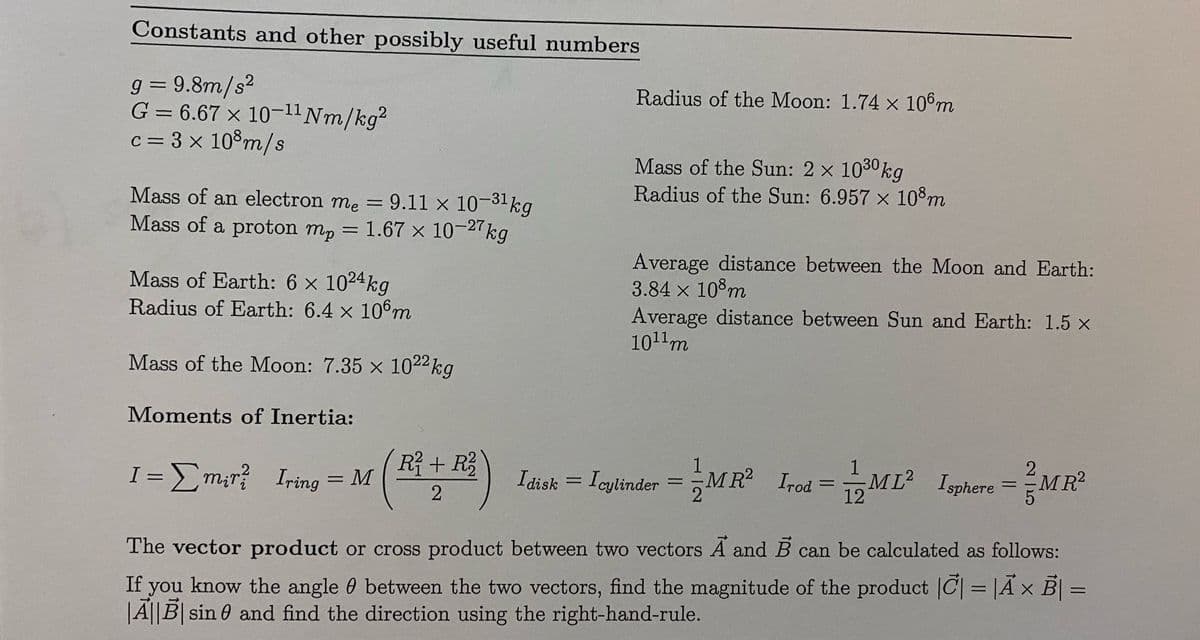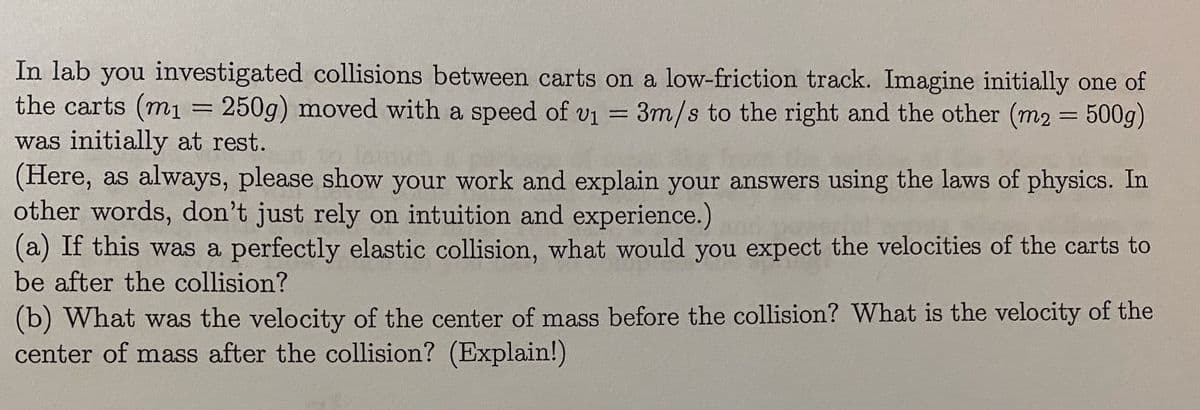n lab you investigated collisions between carts on a low-friction track. Imagine initially one of he carts (m1 = 250g) moved with a speed of v1 vas initially at rest. Here, as always, please show your work and explain your answers using the laws of physics. In ther words, don't just rely on intuition and experience.) a) If this was a perfectly elastic collision, what would you expect the velocities of the carts to pe after the collision? b) What was the velocity of the center of mass before the collision? What is the velocity of the enter of mass after the collision? (Explain!) = 3m/s to the right and the other (m2 = 500g)
n lab you investigated collisions between carts on a low-friction track. Imagine initially one of he carts (m1 = 250g) moved with a speed of v1 vas initially at rest. Here, as always, please show your work and explain your answers using the laws of physics. In ther words, don't just rely on intuition and experience.) a) If this was a perfectly elastic collision, what would you expect the velocities of the carts to pe after the collision? b) What was the velocity of the center of mass before the collision? What is the velocity of the enter of mass after the collision? (Explain!) = 3m/s to the right and the other (m2 = 500g)
Glencoe Physics: Principles and Problems, Student Edition
1st Edition
ISBN:9780078807213
Author:Paul W. Zitzewitz
Publisher:Paul W. Zitzewitz
Chapter9: Momentum And Its Conservation
Section9.1: Impulse And Momentum
Problem 2PP
Related questions
Question

Transcribed Image Text:Constants and other possibly useful numbers
g = 9.8m/s?
G = 6.67 × 10-11 Nm/kg?
c= 3 x 10°m/s
Radius of the Moon: 1.74 x 106m
Mass of the Sun: 2 x 1030kg
Radius of the Sun: 6.957 x 10°m
Mass of an electron me =9.11 x 10-31kg
Mass of a proton mp
1.67 x 10-27kg
%3D
Average distance between the Moon and Earth:
3.84 x 10 m
Average distance between Sun and Earth: 1.5 x
1011m
Mass of Earth: 6 x 1024kg
Radius of Earth: 6.4 x 106m
Mass of the Moon: 7.35 x 1022kg
Moments of Inertia:
R+ R
2.
MR²
1
2
I =Em;r? Iring = M
Idisk =ML Igphere =M R
= Icylinder =MR Irod
I disk
%3D
%D
%3D
12
The vector product or cross product between two vectors A and B can be calculated as follows:
If you know the angle 0 between the two vectors, find the magnitude of the product |C| = |Ã × B| =
|A||B| sin 0 and find the direction using the right-hand-rule.
%3D

Transcribed Image Text:In lab you investigated collisions between carts on a low-friction track. Imagine initially one of
the carts (m1 = 250g) moved with a speed of vi = 3m/s to the right and the other (m2 = 500g)
was initially at rest.
(Here, as always, please show your work and explain your answers using the laws of physics. In
other words, don't just rely on intuition and experience.)
(a) If this was a perfectly elastic collision, what would you expect the velocities of the carts to
be after the collision?
(b) What was the velocity of the center of mass before the collision? What is the velocity of the
center of mass after the collision? (Explain!)
Expert Solution
This question has been solved!
Explore an expertly crafted, step-by-step solution for a thorough understanding of key concepts.
This is a popular solution!
Trending now
This is a popular solution!
Step by step
Solved in 3 steps with 3 images

Recommended textbooks for you

Glencoe Physics: Principles and Problems, Student…
Physics
ISBN:
9780078807213
Author:
Paul W. Zitzewitz
Publisher:
Glencoe/McGraw-Hill

Classical Dynamics of Particles and Systems
Physics
ISBN:
9780534408961
Author:
Stephen T. Thornton, Jerry B. Marion
Publisher:
Cengage Learning

Astronomy
Physics
ISBN:
9781938168284
Author:
Andrew Fraknoi; David Morrison; Sidney C. Wolff
Publisher:
OpenStax

Glencoe Physics: Principles and Problems, Student…
Physics
ISBN:
9780078807213
Author:
Paul W. Zitzewitz
Publisher:
Glencoe/McGraw-Hill

Classical Dynamics of Particles and Systems
Physics
ISBN:
9780534408961
Author:
Stephen T. Thornton, Jerry B. Marion
Publisher:
Cengage Learning

Astronomy
Physics
ISBN:
9781938168284
Author:
Andrew Fraknoi; David Morrison; Sidney C. Wolff
Publisher:
OpenStax